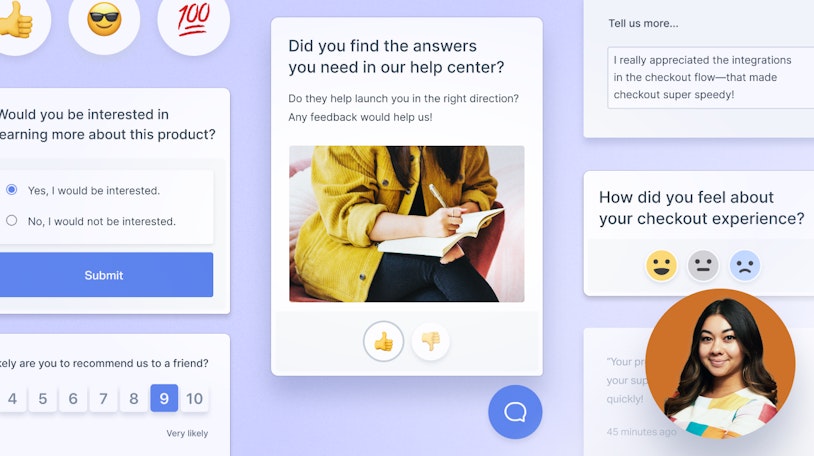If you’re in ecommerce or retail management, omnichannel retail is a term you might be familiar with. Simply put, it’s about offering a consistent, engaging customer experience, no matter how or where your customer chooses to shop. This can be online from any device, via telephone, or in a physical store.
In this article, we’ll take a closer look at omnichannel retail, discuss successful (and not so successful) examples to understand the concept better, and identify the emerging trends to watch out for. We'll also talk about how omnichannel retailing impacts customer experiences and recommend ways you can effectively measure its success.
What is omnichannel retail?
Omnichannel retail is a multi-channel retailing strategy that integrates shopping experiences across all platforms and devices. It ensures seamless, consistent, and aligned customer interactions, regardless of how, when, or where a customer accesses a product or service. Omnichannel retailing effectively provides an integrated and cohesive customer shopping experience from the first touchpoint to the last.
Traditional retail methods often focus on individual touchpoints like a website, a physical store, or a marketing campaign. But customers see all interactions with a brand as a single, unified experience, whether they're browsing your online store, checking product reviews on social media, or visiting your brick-and-mortar location, realigning your business strategies around the customer perspective.
Implementing an effective omnichannel approach isn't just about staying competitive in today's market — it's about meeting your customers where they are, providing exceptional service, and, ultimately, building long-lasting relationships. At the end of the day, a satisfied customer can be your brand's best advocate.
Benefits of omnichannel retail
In the diverse landscape of retail strategies, omnichannel retail stands out for its customer-centric approach. To appreciate its full impact, let's first contrast it with other popular retail models: multichannel and single-channel strategies.
In a single-channel retail strategy, a business sells its products or services via one channel only, such as a physical store or an online marketplace. While this strategy is simpler, it limits customers' access and choices.
Multichannel retailing goes a step further by allowing businesses to sell through multiple, distinct channels. Although this expands customer access, the channels often operate independently of each other. This can result in disjointed customer experiences.
Omnichannel retail solves this challenge by integrating all customer touchpoints. It's more than just selling through different channels: It is about aligning those channels to offer a seamless and unified customer experience, regardless of where the customer chooses to connect.
Here are some of the advantages of implementing an omnichannel retail strategy:
Enhanced customer experience: Customers expect convenience and consistency. Omnichannel retail ensures they can engage with your brand when and where they prefer, with a unified experience across all touchpoints.
Increased sales and conversions: When barriers between channels are removed, customers can easily proceed from browsing to purchasing. This leads to higher conversion rates and sales. Moreover, research shows that omnichannel customers often spend more compared to single-channel consumers.
Loyalty and retention: By providing a superior customer experience, omnichannel retail is an effective way to build brand loyalty and customer retention. Happy customers are more likely to return and engage with brands that offer seamless shopping experiences.
Valuable insights: Omnichannel strategies require a synchronized view of customer data. This integrated data gives valuable insight into customer behavior and preferences, aiding targeted marketing and better decision-making.
Competitive advantage: Adapting to omnichannel retail enables you to meet and exceed customer expectations better than competitors stuck to single or multichannel strategies, providing a significant advantage in the current retail landscape.
Choosing an omnichannel strategy can bring considerable benefits to your business operations. It places customers firmly at the center and attentively caters to their demands for a consistent, optimized shopping experience. This, in turn, can lead to increased sales, customer satisfaction, and long-term business growth.
Successful omnichannel retail examples
When done right, omnichannel retail can massively ramp up your customers' shopping experiences. Let's look at some success stories and see what we can learn from them.
The magic behind Sephora's omnichannel experience
Sephora, a renowned cosmetics brand, made exceptional strides in the world of omnichannel retail with their innovative app, a partnership between the brand and Map My Beauty. Known as Sephora to Go, the app included a Pocket Contour feature that allowed users to learn more about contouring and even tailor a contour strategy to their own faces, merging the physical and digital world beautifully. It helped customers learn about and select products based on their specific facial features, allowing them to find the perfect foundation and concealer shades, consolidating their in-store and online experiences.
How Starbucks brews a perfect blend of omnichannel strategy
Starbucks operates a mobile app that tightly interweaves the digital and physical realms, allowing customers to order ahead, customize their beverages, get personalized recommendations, and even pay, all from one user-friendly platform. Additionally, the Starbucks Rewards Program keeps customers engaged with enticing star points that can be accumulated and redeemed both in-store and online.
Bringing it into focus: Warby Parker's omnichannel expedition
Warby Parker, the online eyeglasses specialist, realized the tactile experience of trying on eyeglasses was essential for consumers, so they branched out into brick-and-mortar stores. They ensure continuity by allowing customers to upload their prescriptions online, choose five frames to test at home, and purchase the pair they like the best. This digital-physical medley allows them to maintain their online convenience while providing that instant gratification of an in-store shopping spree. Bringing the omnichannel experience full-circle, online shoppers can also bring their glasses into brick-and-mortar Warby Parker locations for adjustments.
Contemplating failed omnichannel retail examples
Now that we've looked at some wins, it's only fair we address the losses, too. Understanding where others have stumbled can prevent us from making the same mistakes.
Toys 'R' Us
Toys 'R' Us tried to navigate the omnichannel retail route. However, the disconnect between their online and in-store experiences created confusion and frustration for customers. Online deals weren't always valid in-store, and their locations often failed to reflect the full product range available online. This disharmony drowned their omnichannel efforts, warning us of the vital importance of a consistent customer experience across all channels.
Marks & Spencer
Marks & Spencer learned the hard way that a failure to fully integrate systems across channels can create more problems than it solves. Despite their substantial investment in an online update, differences in pricing, promotions, and product ranges across channels led to customer dissatisfaction. This mismatch emphasizes that a seamless and consistent user journey is non-negotiable in a successful omnichannel strategy.
Nailing an omnichannel strategy isn't about simply existing on multiple platforms; it's about creating a fluid and consistent experience across all those platforms. Hopefully, these examples give you some guidance or, at the very least, some food for thought as you reimagine your own omnichannel strategy.
Emerging omnichannel retail trends
Rapid innovation in technology and ever-evolving customer expectations continue to reshape the retail industry. As a result, keeping up with emerging trends in omnichannel retail is becoming more crucial than ever. Let's explore some of these developments and the impact they have on businesses like yours.
Personalized, customer-centric experiences
One of the biggest trends in omnichannel retail revolves around customer-centricity. Today's customers expect frictionless experiences across all touchpoints with personalization, convenience, and seamless integration as their top priorities. Advanced tools like AI and software solutions that focus on customer satisfaction and engagement are now being adopted at an increasing rate to meet these demands.
Help Scout's shared inbox is a prime example of these solutions, providing a streamlined platform to manage customer interactions from multiple channels like email, FB Messenger, Instagram, and live chat, all from a single inbox. This centralized approach — along with features like collision detection and AI tools — enables your team to deliver rapid, consistent responses that keep your customers happy.
Experiential retail
This trend involves creating immersive, engaging experiences that go beyond making a purchase, such as workshops, events, or technology-driven product demonstrations. Research shows it works, with 74% of shoppers saying they’re likely to buy promoted products after an experience. The goal of experiential retail is to build connections between your brand and your customers in order to drive both sales and loyalty.
Demand for transparency and ethical business practices
According to research conducted by Open Text, more and more consumers seek to align themselves with brands that deliver quality while demonstrating a strong commitment to ethical sourcing, sustainable practices, and transparent operations. This trend transcends traditional retail boundaries and applies across all channels and departments — from in-store interactions to online purchases to interactions with your customer support department. Retailers who choose to embrace transparency and uphold ethical business standards will be able to build a deeper rapport with their customers and foster a sense of trust and loyalty.
The omnichannel retail customer experience
Providing top-notch customer experiences is the beating heart of successful omnichannel retail. However, it's not just about creating great individual interactions. Success depends on the coherence and consistency of these interactions across all channels. In an age where customers might start researching a product on their mobile devices, continue on their desktops, and finally make a purchase in a physical store, harmonizing these touchpoints is crucial. Remember, inconsistency breeds confusion, while consistency fosters trust, and that's what we aim for.
Techniques for creating a positive omnichannel retail experience
Crafting a positive omnichannel experience requires a careful blend of ecommerce best practices in technology, strategy, and empathy. Here are a few key techniques:
Know your customer: Understand your customers’ preferences, behaviors, and the channels they commonly use. Segment your customers and tailor individual experiences based on these insights.
Ensure seamless channel transitions: Design your customer journey so that a customer can switch from one channel to another seamlessly without losing context. For instance, if a customer adds a product to their cart online, they should be able to view it in their mobile app, too.
Leverage technology: Intelligent tools can be used to gather feedback from customers as well as automate and streamline the shopping experience, making it more personalized and hassle-free.
Train your staff: Ensure your team understands the value of omnichannel retailing and how each channel interacts with the others.
Assessing the success of your omnichannel retail strategy
To keep your strategy on the right track, monitoring and measurement are key. Here are a few metrics commonly tracked in customer service software that can provide insights into your omnichannel performance:
Customer Satisfaction Score (CSAT): By measuring how satisfied customers are with your brand or individual experiences, you can identify areas for improvement.
Net Promoter Score (NPS): The NPS identifies the likelihood of customers recommending your brand to others, providing insights into customer loyalty.
Customer Effort Score (CES): CES measures how easy it is for customers to interact with your brand across channels.
Sales metrics: Monitor your sales, conversion rates, average order value, and other financial metrics across different channels to evaluate your success.
Tracking these metrics consistently over time can help you identify patterns, recognize opportunities, and fix any gaps in your omnichannel strategy.
Meeting the challenges of building an omnichannel brand
Throughout our discussion of omnichannel retail, one thread has carried through: It’s important to provide a seamless and satisfying customer experience across all touchpoints. With the strategies we’ve shared here, along with the integration of technology, you can elevate customer engagement and ensure your brand stays relevant.
Beyond that, regular assessments of key performance metrics are important to ensuring your strategy's effectiveness. This allows for adjustments and improvements, keeping your approach flexible and responsive to your audience's evolving needs. As you move forward, keep customer satisfaction at the heart of your efforts, and you’ll be rewarded with customer loyalty and increased revenue.











